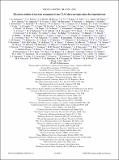Electroexcitation of nucleon resonances from CLAS data on single pion electroproduction
Author(s)
Suleiman, R.
DownloadAznauryan-2009-Electroexcitation of nucleon resonances from CLAS data on single pion electroproduction.pdf (1.124Mb)
PUBLISHER_POLICY
Publisher Policy
Article is made available in accordance with the publisher's policy and may be subject to US copyright law. Please refer to the publisher's site for terms of use.
Terms of use
Metadata
Show full item recordAbstract
We present results on the electroexcitation of the low mass resonances Δ(1232)P[subscript 33], N(1440)P[subscript 11], N(1520)D[subscript 13],
and N(1535)S11 in a wide range of Q[superscript 2]. The results were obtained in the comprehensive analysis of data from
the Continuous Electron Beam Accelerator Facility (CEBAF) large acceptance spectrometer (CLAS) detector at
the Thomas Jefferson National Accelerator Facility (JLab) on differential cross sections, longitudinally polarized
beam asymmetries, and longitudinal target and beam-target asymmetries for π electroproduction off the proton.
The data were analyzed using two conceptually different approaches—fixed-t dispersion relations and a unitary
isobar model—allowing us to draw conclusions on the model sensitivity of the obtained electrocoupling
amplitudes. The amplitudes for the Δ(1232)P[subscript 33] show the importance of a meson-cloud contribution to
quantitatively explain the magnetic dipole strength, as well as the electric and scalar quadrupole transitions.
They do not show any tendency of approaching the pQCD regime for Q[superscript 2] ≦ 6 GeV2. For the Roper resonance,
N(1440)P[subscript 11], the data provide strong evidence that this state is a predominantly radial excitation of a three-quark
(3q) ground state. Measured in pion electroproduction, the transverse helicity amplitude for the N(1535)S[subscript 11]
allowed us to obtain the branching ratios of this state to the πN and ηN channels via comparison with
the results extracted from η electroproduction. The extensive CLAS data also enabled the extraction of the
γ
∗
p → N(1520)D[subscript 13] and N(1535)S[subscript 11] longitudinal helicity amplitudes with good precision. For the N(1535)S[subscript 11],
these results became a challenge for quark models and may be indicative of large meson-cloud contributions or of
representations of this state that differ from a 3q excitation. The transverse amplitudes for the N(1520)D[subscript 13] clearly
show the rapid changeover from helicity-3/2 dominance at the real photon point to helicity-1/2 dominance at
Q2 > 1 GeV[superscript 2], confirming a long-standing prediction of the constituent quark model.
Date issued
2009-11Journal
Physical Review C
Publisher
American Physical Society
Citation
CLAS Collaboration et al. “Electroexcitation of Nucleon Resonances from CLAS Data on Single Pion Electroproduction.” Physical Review C 80.5 (2009) : 055203. © 2009 The American Physical Society
Version: Final published version
ISSN
0556-2813